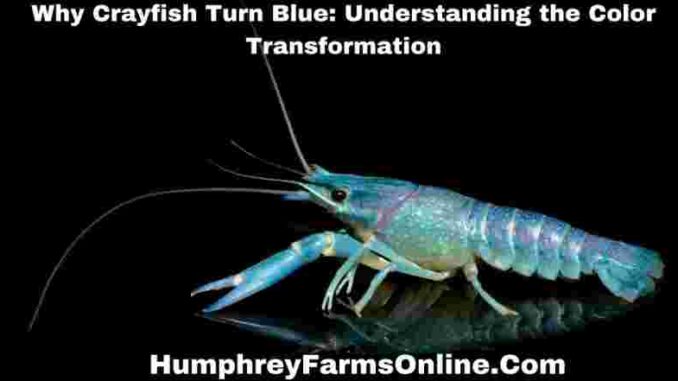
Why Crayfish Turn Blue: Crayfish, those fascinating little crustaceans found in freshwater environments, often display a range of colors.
Among the most eye-catching is their striking blue hue. If you’ve ever wondered why crayfish turn blue, you’re not alone.
This transformation is closely tied to a natural process known as molting. Let’s dive into the reasons behind this vibrant change and what it means for your crayfish.
Also, Read
Where Crayfish Live: A Comprehensive Guide
What Crayfish Eat: A Comprehensive Guide to Their Diet
The Molting Process: A Key to the Blue Coloration
What Is Molting?
Molting is a crucial process in the life of a crayfish. It involves shedding its old exoskeleton to allow for growth and to replace damaged or worn-out parts. During this period, the crayfish will temporarily change colors. This color change is an indication that the crayfish is in the midst of or has just completed the molting process.
Temporary Color Change
- Initial Molting Phase: When a crayfish begins to molt, its color can become dull or even appear faded. This temporary lack of color can be misleading, as it may suggest the crayfish is unwell.
- Post-Molt Regrowth: After shedding its old exoskeleton, the crayfish will gradually regain its original color. Within approximately two weeks, it will return to its vibrant and healthy hue.
The Electric Blue Transformation
Why the Blue Color?
- New Exoskeleton: The electric blue coloration is most prominent when a crayfish has a fresh, new exoskeleton. This brilliant blue color is due to specific pigments and proteins in the new shell.
- Sign of Health: A crayfish displaying a vivid blue hue is often a sign of good health and a successful molting process. It indicates that the crayfish has effectively replaced its old exoskeleton and is now thriving.
Duration of the Blue Color
- Temporary Appearance: The blue coloration is not permanent. It will gradually fade as the crayfish’s new exoskeleton continues to harden and stabilize.
- Color Reversion: After the initial bright blue phase, the crayfish may return to its usual color or a slightly different shade, depending on its species and environmental factors.
What to Do If Your Crayfish Isn’t Blue
If you receive a crayfish that isn’t displaying the vibrant blue color, don’t worry. It might simply be in the process of molting. As it progresses through this phase, you can expect the crayfish to regain its beautiful blue color in due course.
Key Takeaways
- Molting and Color Change: Crayfish turning blue is a normal part of the molting process, indicating a healthy crustacean transitioning to a new exoskeleton.
- Color Return: Expect a return to the electric blue coloration within about two weeks after the molting process.
Understanding why crayfish turn blue helps in appreciating the natural processes they undergo and ensures that you can provide the best care for these fascinating creatures. If you notice a crayfish in the midst of this transformation, know that it’s a positive sign of growth and renewal.
How Rare Are Blue Crayfish?
The blue crayfish, scientifically known as Procambarus alleni, is a striking freshwater crustacean that captivates with its brilliant sapphire color and impressive claws. However, despite their vibrant appearance, these fascinating creatures are relatively rare in their natural habitat. Let’s explore the rarity of blue crayfish and the factors influencing their populations.
The Restricted Natural Range of Blue Crayfish
Limited and Isolated Habitats
One of the primary reasons for the blue crayfish’s rarity is its extremely limited natural habitat. This species is native to a very specific area: the Apalachicola River basin in Florida’s panhandle. Within this region, blue crayfish are found only in a few isolated wetlands, such as McKinney Pond, Rice Pond, and Magnolia Pond. Overall, they inhabit less than 5 square miles of swampy, cypress-dominated waters.
Specialized Environmental Requirements
The blue crayfish thrive in very particular environmental conditions. They prefer shallow, still waters with sandy substrates and abundant aquatic vegetation. These specific needs make their natural habitat scarce and further restrict their distribution.
Threats to Blue Crayfish Wild Populations
Declining Numbers and Current Estimates
Given their small and fragmented natural range, blue crayfish populations in the wild are sparse. While exact numbers are hard to pin down, scientific surveys have reported very low population densities, with only a few individuals caught in some areas. The overall population is estimated to be in the hundreds or low thousands.
Risks and Potential Endangerment
The blue crayfish face several significant threats, including habitat destruction from urban development, pollution, and droughts. These factors lead to the degradation and shrinking of their wetland habitats. Many experts believe that without protective measures, the species could become endangered.
The Surge of Blue Crayfish in the Aquarium Market
Rise in Popularity for Home Aquariums
Ironically, while the blue crayfish is rare in the wild, it has become quite common in the aquarium trade. Introduced to the hobbyist market in 2003, their stunning appearance quickly made them a favorite among aquarium enthusiasts. The demand for these crayfish surged dramatically, especially after photos of their vivid color went viral on social media in late 2017.
The Contrast Between Captive Abundance and Wild Scarcity
Captive breeding has led to a significant increase in the availability of blue crayfish. Due to their rapid reproduction in controlled environments, they are now widely available and relatively affordable in pet stores and online. This abundance in captivity starkly contrasts with their scarcity in the wild.
Impacts of Captive Populations on Wild Blue Crayfish
Benefits and Risks of Captivity
The thriving blue crayfish population in captivity has alleviated some collection pressures on wild populations, potentially aiding conservation. However, this situation introduces new risks. For example, accidental or intentional releases of captive crayfish into non-native habitats could lead to invasive species issues.
Importance of Proper Management and Regulation
Captive breeding also raises concerns about genetic dilution and disease transmission. To mitigate these risks, strict management and regulation of the aquarium trade are crucial to prevent adverse effects on wild populations.
Is the Blue Crayfish at Risk of Extinction?
Current Conservation Status and Future Concerns
Despite the blue crayfish’s rarity in the wild, it is not currently listed as an endangered species. The lack of definitive data and the contrast with their captive abundance contribute to this status. However, ongoing habitat loss and population declines suggest that conservation measures may be necessary in the near future.
Conservation Prospects and Recommendations
Measures to Protect and Preserve Blue Crayfish
To ensure the survival of the blue crayfish, several conservation strategies are recommended:
- Protecting and preserving their remaining wetland habitats
- Establishing protected reserves for vulnerable populations
- Monitoring wild populations to assess trends and threats
- Regulating the pet trade to prevent over-harvesting
- Promoting responsible pet ownership to avoid accidental releases
Strategies for Effective Conservation and Management
Implementing these measures can help safeguard the blue crayfish’s future. Continued research and proactive conservation efforts are essential to address the challenges faced by this unique species and ensure its long-term survival in the wild.
What Is A Blue Crawfish?
If you’re wondering what a blue crawfish is, you’re in the right place. Blue crawfish, also known as blue crayfish, are a fascinating species that stand out due to their vibrant color and distinctive features. Below, we’ll cover everything you need to know about blue crayfish, from their care and habitat to their diet and breeding.
Introduction to Blue Crawfish
Blue Crayfish Overview
The blue crayfish, scientifically named Procambarus alleni, is a striking freshwater crustacean. Commonly referred to as blue lobsters, Florida crayfish, electric blue crayfish, Everglades crayfish, and sapphire crayfish, these creatures are admired for their brilliant blue coloration. While the aquarium variety is primarily blue, wild specimens can also be found in colors like white, red, and brown.
Why Blue Crawfish Are Popular
These crayfish are renowned for their hardiness and ease of care, making them a popular choice among aquarium enthusiasts. They are not overly demanding regarding water quality and are omnivorous, which adds to their appeal, especially for beginners interested in breeding crayfish.
Natural Habitat and Origin
Where Blue Crawfish Come From
Blue crayfish are native to freshwater marshes, streams, and wetlands primarily in Florida, south of the panhandle. Although they have also been found in places like California, France, and Germany, these instances are likely due to aquarium releases rather than natural populations.
Environmental Adaptations
These crayfish thrive in stagnant or slow-moving waters. They can endure dry periods by burrowing into sand, mud, or clay. Some of their habitats even have brackish conditions with salinity levels of up to 18 parts per thousand.
Characteristics of Blue Crayfish
Size and Lifespan
Blue crayfish typically grow to 4-5 inches (10-12 cm) in length. In the wild, some individuals may reach up to 7 inches (18 cm). With proper care, they can live up to 5 years.
Color Variations
While blue is the most common color due to selective breeding, blue crayfish can also appear in shades of red, orange, and brown. Their vibrant blue color is especially prized in the aquarium trade.
Distinguishing Blue Crayfish
Comparing Blue Crayfish Species
It’s important to differentiate Procambarus alleni from similar species like Procambarus clarkii. The key difference is the areola—the small gap between the carapace plates. Blue crayfish have nearly touching plates, while Procambarus clarkii has almost no gap.
Other Similar Species
Blue crayfish can also be confused with Procambarus virginalis. Understanding these subtle differences is crucial for proper identification and care.
Behavior and Care Requirements
Behavior and Social Needs
Blue crayfish are nocturnal and enjoy darkness. They are highly territorial and aggressive, making it challenging to house them with other crayfish or fish. Providing ample hiding spots is essential if you plan to keep multiple crayfish in the same tank.
Molting and Growth
Molting is a vital part of crayfish growth. Blue crayfish molt frequently when young—every few days to weeks—and less often as adults. Providing plenty of hiding spots and a calcium-rich diet can help ensure successful molting.
Tank Setup and Maintenance
Tank Size and Setup
For a single blue crayfish, a minimum tank size of 20 gallons (90 liters) is recommended. They need a well-structured environment with sand or gravel substrate for burrowing and plenty of hiding spots.
Water Parameters
- Temperature: Ideal range is 68-75°F (18-24°C).
- pH: Maintain a stable pH between 7.0 and 8.0.
- Hardness: General hardness (GH) of 6-8 and carbonate hardness (KH) of 4-6 are optimal.
- Filtration: Use a filter with a sponge cover to avoid crayfish interference.
Additional Equipment
- Filter: Marineland Penguin Power, Sponge filter
- Bubbler: Hygger Aquarium Air Stone Kit
- Substrate: Carib sea sand, Play sand
- Decor: Malaysian Driftwood, PVC pipes, Coconuts
Feeding and Diet
What Blue Crayfish Eat
Blue crayfish are omnivorous and eat a variety of foods including:
- Protein Sources: Shrimp tails, fish pellets, bloodworms
- Vegetables: Peas, romaine lettuce, carrots
- Calcium: Eggshells, cuttlebone
Regular feeding is essential, but avoid overfeeding. Remove uneaten food after 24 hours.
Breeding Blue Crayfish
Breeding and Raising Young
Breeding blue crayfish requires ample space and a separate tank for the female once she has eggs. Eggs typically hatch in 20-30 days, and the young crayfish will stay with their mother for a short period before dispersing.
Important Breeding Tips
- Provide plenty of hiding spots for both adults and young crayfish.
- Separate the female from the tank after egg detachment to prevent cannibalism.
Conclusion
Blue crayfish are captivating creatures with unique behaviors and care requirements. While they are hardy and relatively easy to maintain, their aggressive nature and specific habitat needs make them best suited for experienced aquarists. Whether you’re fascinated by their striking color or their intriguing behaviors, blue crayfish are a rewarding addition to any aquarium setup.

Leave a Reply
You must be logged in to post a comment.